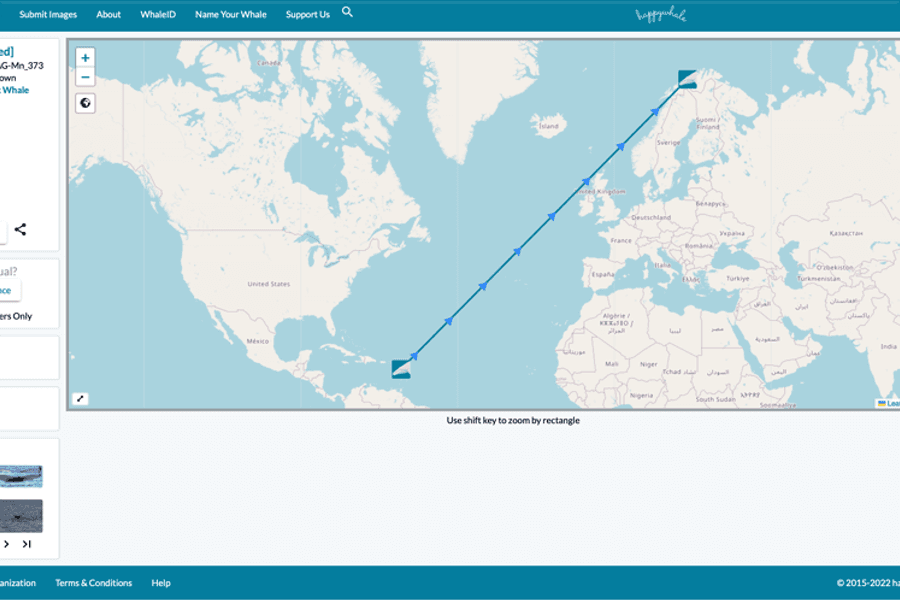Leonie Leppie explains how half a year on the North Sea has added to our global knowledge about humpbacks.
My name is Leonie, and I have been an Ocean Conservationist since May 2022 onboard Hurtigruten MS Otto Sverdrup, a 500-passenger expedition cruise ship. During my time on board, I’ve enjoyed seeing the different seasons pass by, whilst sailing along the stunning Norwegian coastline. Departing from Hamburg, we cross the North Sea into Norwegian waters and its meandering fjords. The journey’s highlight is the North Cape or “lands’ end”- a raggedy and bare, yet astonishingly beautiful part of the world.
As the seasons pass and change, I have been lucky enough to see diverse species of cetaceans, including large numbers of elegant and playful humpbacks. There is nothing more exciting for the guests (and me) than observing the backs of these giants rising, momentarily breaking up the surface, and then vanishing into the deep blue sea. The passengers crowd the deck to find the best vantage point all trying to get a glimpse of the whales.
On some days, my wildlife watches on deck are relatively quiet, giving us time to reflect or talking with guests about interesting things that are passing by. But everything is different when we move into nutrient-rich waters, and the whale sightings begin. . The guests are in awe. Other than their excited voices and all that can be heard is the clicking sound of cameras.
Spotting whales is what we all want. . We all love to stand and marvel at these beautiful creatures, but critically, I also need to collect data about what we see! I always have my iPad and binoculars - the two items we need to survey and record data and also manage to sling a camera with a huge 200mm lens around my shoulder. It’s a high-speed, multitasking effort. I count the number of cetaceans, identify them to species level if possible and log their approximate distance in the ORCA OceanWatchers app. Once that’s done, I swing my camera around, ready to snap a photo and my aim is to get the best fluke (tail) shots of these humpback whales. And I shall tell you why!
Just like our fingerprint or a zebra’s stripes, every humpback can be identified via its unique fluke. Variations of dark, white, or brown patches, scratches, lumps, barnacle rings or other marks on the underside of a humpback’s fluke are what makes them individually identifiable.
ORCA itself doesn’t catalogue the individual animals, but there is an organisation that does: Happywhale. Since 2015, Happywhale has received hundreds of thousands of fluke photos, waiting to be matched to their database. Through a smart-image processing algorithm, the software can identify features in the photographs and match them with photos already submitted to the database. The user that has submitted images, will soon get notified if their whale is new to science or whether it has been matched with other fluke snapshots. You can then follow the journey made by the whale, by following the photo ID matches around the world! How amazing is that…and what an incentive to capture the best fluke photo possible.
ORCA and Happywhale, like many cetacean organisations, share a similar mission: they want to engage with people to understand cetaceans through data collection, and subsequently use this to better protect these magnificent giants in their ocean environment. Hurtigruten Expeditions supports this, too! It partners with ORCA by having Ocean Conservationists onboard on their Expedition fleet, but they also they fund projects with Happywhale, such as giving financial support to develop an improved identification software for this pioneering image recognition. Why does all this matter? The science team (including ORCA) onboard MS Otto Sverdrup took the opportunity and connected the dots and what happened next is citizen science in action (and also very exciting!)
Starting in May 2022 and for the next six months, everyone on board that had a camera, whether they were guests or crew, and who had taken photos of the humpback whale flukes, was asked to email them off to Happywhale. We had lots of matches with photographs within their existing database: humpbacks that had been seen in the area before, but also some that were (amazingly) sighted as far away as Guadeloupe or hadn’t been seen since 2017!
To follow the story of these whales, Happywhale offers an adoption scheme where you donate $500 to a marine conservation charity of your choice, and the whale is yours to name. Here we are connecting the dots. On MS Otto Sverdrup, we adopted several whales with the support of Ted Cheeseman, co-founder of Happywhale, donating to ORCA, the team onboard Otto Sverdrup named five of the whales: Otto, Louisa, Charlotte-Elisabeth, Olav, and Ute. On each of these journeys, where whale images could be matched, the guests now have a long-lasting memory of their adopted whale. Even those guests that have not seen any cetaceans have learnt about the significant work that ORCA Ocean Conservationists are doing onboard, their contribution to the protection of cetaceans and the whales’ importance in the marine ecosystem.
If you would like to see photographs of the whales that MS Otto Sverdrup has submitted, follow the link to HappyWhale (https://happywhale.com/user/9472).



